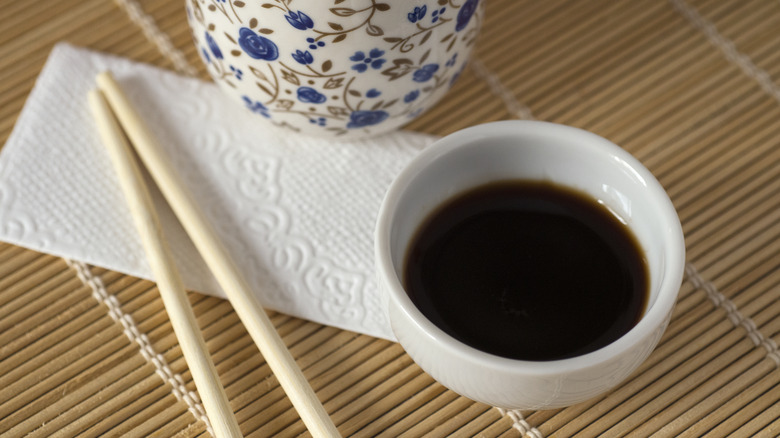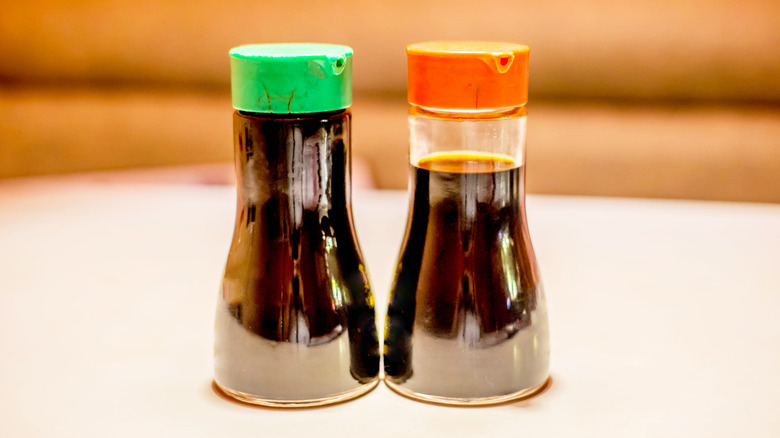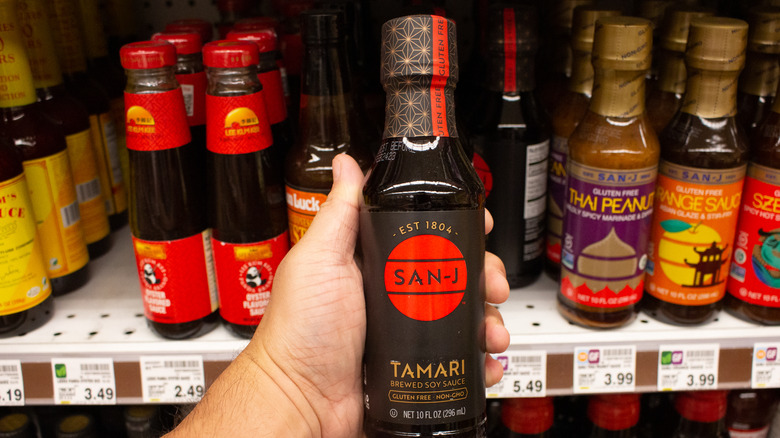Is There A Difference Between Soy Sauce And Tamari?
Whether you're making a stir-fry at home, eating at your favorite sushi restaurant or dribbling it on ice cream, soy sauce is a ubiquitous staple for many of us. Made with savory fermented ingredients and plenty of salt, soy sauce gives a rich umami flavor to a wide variety of dishes and tastes incredible when paired with butter. But while restocking this swiss army knife of a condiment, you've probably noticed bottles of tamari right next to the soy sauce and wondered about the differences between the two. Are soy sauce and tamari one and the same?
While soy sauce and tamari share some things in common — both sauces have a similar appearance and are made from flavor-rich fermented soybeans – they each have slightly different ingredients, fermentation processes, taste and texture. While the two sauces can be substituted for each other in recipes, the most distinct difference between the two is that tamari is typically gluten free and made from rice, whereas soy sauce is made with wheat.
What is soy sauce?
Soy sauce is a popular Chinese condiment made out of fermented soybeans, water, roasted wheat and salt. Dark brown in hue, it's known for its salty, savory taste that enhances the flavor of a wide variety of dishes. Soy sauce gets its umami taste from the fermentation process which involves soaking soybeans in water and steaming them before combining them with a flour made from roasted wheat and a fermenting agent like Koji, a mold that's also used to make sake and miso.
Chinese soy sauce generally falls into two categories — light and dark. The type of soy sauce you typically see at North American grocery stores and tucked into the bag with your Chinese takeout is light soy sauce, which tends to be lighter coloured and thinner in consistency. On the other hand, dark soy sauce has a longer fermentation process, which gives it a deeper hue and flavor. It's also common to add sugar and molasses to dark soy sauce which gives it a hit of sweetness and a thicker texture.
A soy sauce's taste, texture and color depends entirely on its ingredients, where it's made and how long it's been fermented. While soy sauce is a mainstay in Chinese cooking, there's also Japanese, Indonesian, Korean, Taiwanese and other varieties, each with their own unique flavor profile. (Think: mushroom soy sauce that's a staple in Southeast Asian cuisine.)
Soy sauce is incredibly versatile and can be used alone as a table condiment or to build other sauces and marinades. You can even use soy sauce to poach chicken.
What is tamari?
Tamari is a kind of Japanese soy sauce that's made with fermented soybeans, water, salt and fermented rice. Compared to regular soy sauce, which can be quite strong and salt-forward, tamari is known for having a smoother, less salty finish and a richer umami rich flavor. The main difference between tamari and regular soy sauce comes down to the ingredients and how it's made. Whereas regular soy sauce is made with a 50/50 combination of soybeans and wheat, most tamari doesn't contain any wheat and instead, contains a higher concentration of soybeans.
Tamari is a bi-product of making miso – the fermented soybean paste that's a hallmark of Japanese cuisine. Originating in China and brought to Japan in the 7th century AD, Miso is made by boiling and fermenting soybeans. During this fermentation process, miso creates a flavourful liquid byproduct known as tamari, which translates in Japanese to "that which accumulates."
Tamari is darker than other soy sauces. Unlike soy sauce which is typically aged for 6 months, tamari is aged for a year or longer. This extended aging process gives tamari a darker hue and allows the salt and soy to blend together really well. The result is a sauce that tastes slightly less salty than other soy sauces while still packing a serious umami punch. Because it requires 50 to 80% less water to make, tamari has a thicker consistency than soy sauce.
So, how do you know whether to reach for the soy sauce or tamari? The two are fairly interchangeable. In fact, many recipes will list either as an option. Soy sauce is thinner and has a punchier, saltier flavor compared to the gluten-free tamari. Which one you choose depends what flavors you're hoping to achieve and whether you need a gluten-free option.


